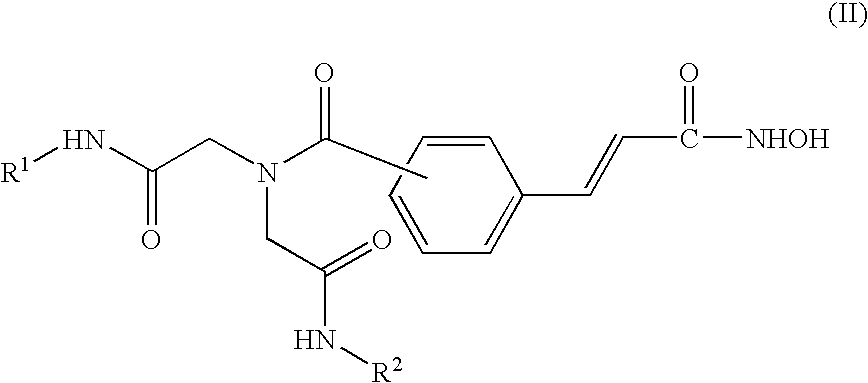Histone deacetylase inhibitors
a technology of histone deacetylase and inhibitors, which is applied in the field of iminodiacetic acid and diamine hydroxamic acid derivatives, can solve the problems of excess proliferation of leukemic cell lines and inability to complete differentiation, and achieve the effects of preventing and/or treating restlessness
- Summary
- Abstract
- Description
- Claims
- Application Information
AI Technical Summary
Benefits of technology
Problems solved by technology
Method used
Image
Examples
example 1
Synthesis
[0299]The compounds of the present invention can be synthesized as exemplified in Schemes 1-4, which illustrate the synthesis of iminodiacetic-acid derived tertiary amine hydroxamic acids (compounds of Formulas II and III). Similar methodologies known to a person skilled in the art can be used to prepare the diamine compounds of Formulas IV and V.
[0300]
[0301]
[0302]
[0303]
[0304]An exemplary non-limiting list of compounds synthesized in accordance with the above-procedures are presented below.
[0305][0306]Comp. 9: 4-(2-Hydroxycarbamoyl-vinyl)-N,N-bis-phenylcarbamoylmethyl-benzamide;[0307]Comp. 10: 4-(2-Hydroxycarbamoyl-vinyl)-N,N-bis-(quinolin-8-ylcarbamoylmethyl)-benzamide;[0308]Comp. 11: 3-[3-(Bis-phenylcarbamoylmethyl-amino)-phenyl]-N-hydroxy-acrylamide;[0309]Comp. 12: 3-{3-[Bis-(quinolin-8-ylcarbamoylmethyl)-amino]-phenyl}-N-hydroxy-acrylamide;[0310]Comp. 13: 3-{3-[Bis-(benzothiazol-2-ylcarbamoylmethyl)-amino]-phenyl}-N-hydroxy-acrylamide;[0311]Comp. 14: 3-[4-(Bis-phenylcar...
example 2
HDAC Inhibition by Novel Compounds
HDAC1-Flag Assay:
[0360]Novel compounds were tested for their ability to inhibit histone deacetylase, subtype 1 (HDAC1) using an in vitro deacetylation assay. The enzyme source for this assay was an epitope-tagged human HDAC1 complex immuno-purified from stably expressing mammalian cells. The substrate consisted of a commercial product containing an acetylated lysine side chain (Biomol Research Laboratories, Inc., Plymouth Meeting, Pa.). Upon deacetylation of the substrate by incubation with the purified HDAC1 complex, a fluorophore is produced that is directly proportional to the level of deacetylation. Using a substrate concentration at the Km for the enzyme preparation, the deacetylation assay was performed in the presence of increasing concentrations of novel compounds to semi-quantitatively determine the concentration of compound required for 50% inhibition (IC50) of the deacetylation reaction.
Results:
[0361]The IC50 values of the compounds descr...
example 3
HDAC Inhibition in Cell Lines
MTS Assay:
[0362]The novel compounds of the instant invention were tested for their ability to inhibit proliferation of the murine erythroleukemia cell line SC9.
[0363]The MTS assay, also referred to as the Cell Titer 96 Aqueous One Solution Cell Proliferation Assay, is a colorimetric method for determining the number of viable cells in proliferation, cytotoxicity or chemosensitivity assays. The MTS reagent contains a novel tetrazolium compound [3-(4,5-dimethylthiazol-2-yl)-5-(3-carboxymethoxyphenyl)-2-(4-sulfophenyl)-2H-tetrazolium, inner salt] and electron coupling reagent (phenazine ethosulfate; PES). Murine erythroleukemia cells (SC-9) were incubated with vehicle or increasing concentrations of compound for 48 hours. Cell proliferation was quantitated by adding a small amount of the MTS reagent directly to culture wells, incubating for 1-4 hours and then recording the absorbance at 490 nM with a 96-well plate reader. The quantity of formazan product, a...
PUM
| Property | Measurement | Unit |
|---|---|---|
| enantiomeric excess | aaaaa | aaaaa |
| enantiomeric excess | aaaaa | aaaaa |
| enantiomeric excess | aaaaa | aaaaa |
Abstract
Description
Claims
Application Information
 Login to View More
Login to View More - R&D Engineer
- R&D Manager
- IP Professional
- Industry Leading Data Capabilities
- Powerful AI technology
- Patent DNA Extraction
Browse by: Latest US Patents, China's latest patents, Technical Efficacy Thesaurus, Application Domain, Technology Topic, Popular Technical Reports.
© 2024 PatSnap. All rights reserved.Legal|Privacy policy|Modern Slavery Act Transparency Statement|Sitemap|About US| Contact US: help@patsnap.com










